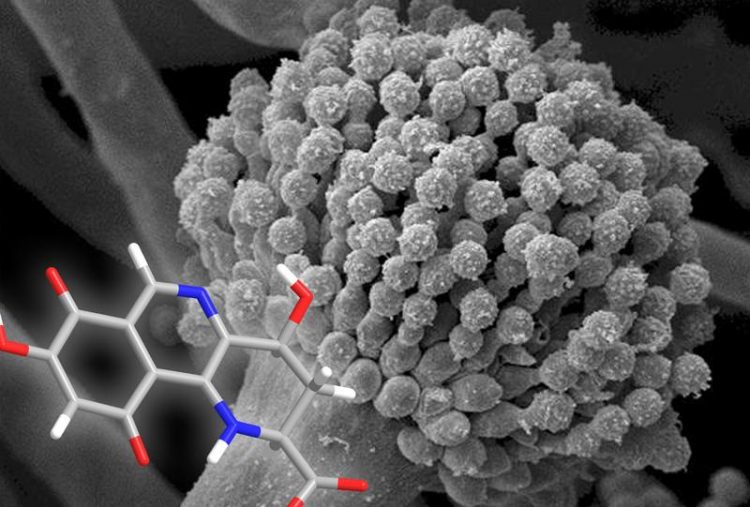Fungi – a promising source of chemical diversity

The fungus Aspergillus fumigatus produces Fumisoquine in a way similar to plants. Jeannette Schmaler-Ripcke, Florian Kloss, Luo Yu / HKI
A large number of drugs used today originate from nature. Most of these molecules, which can be found with or without synthetic modifications and exert their beneficial effect on human health, are derived from microorganisms or plants. Thus, it is of great interest to discover novel active compounds in nature and use them for the treatment of diseases.
One well-known group of plant metabolites are the isoquinoline alkaloids. Today more than 2,500 different types are known and they are mainly found in poppy and barberry plants. Famous examples include the painkiller morphine or the cough remedy codein.
Together with colleagues from the US, scientists in the labs of Dirk Hoffmeister and Axel Brakhage at the Friedrich Schiller University in Jena found out that fungi synthesize certain natural products in a very similar way to plants.
They analyzed the genome of the common mold Aspergillus and discovered a small cluster of genes whose function was previously unknown. Comparing these genetic sequences with known data implied that they might be responsible for the synthesis of novel natural products.
By manipulating the genetic sequences, characterizing the resulting metabolites and using radioactive labeling experiments it was possible to elucidate the structure of the novel molecules and to unravel the detailed biosynthetic pathways.
The researchers discovered a new linkage mechanism for carbon atoms which had never been seen before in fungi. The whole fumisoquin biosynthetic pathway appears to be a combination of plant biosynthetic principles and the non-ribosomal peptide synthetases commonly found in fungi.
Axel Brakhage, university professor and head of the Leibniz Institute for Natural Product Research and Infection Biology, explains: “Fungi and plants diverged early on during evolution. The newly discovered fumisoquin synthesis pathway shows that there was a parallel development for the production of isoquinoline alkaloid compounds in both groups of organisms. This opens up new roads for combinatorial biotechnology in order to advance the search for novel active compounds and thus to develop urgently needed new drugs.”
Dirk Hoffmeister, professor at the Institute for Pharmacy at Friedrich Schiller University, is pleased with the joint efforts: “The published study is a great example of the tight collaboration between the university and the Leibniz Institute for Natural Product Research and Infection Biology – Hans Knöll Institute – and our American partners. Good research does not know any borders.”
The international scientific association “Faculty of 1000“ included this publication in their hit list of seminal research results.
Media Contact
More Information:
http://www.hki-jena.deAll latest news from the category: Life Sciences and Chemistry
Articles and reports from the Life Sciences and chemistry area deal with applied and basic research into modern biology, chemistry and human medicine.
Valuable information can be found on a range of life sciences fields including bacteriology, biochemistry, bionics, bioinformatics, biophysics, biotechnology, genetics, geobotany, human biology, marine biology, microbiology, molecular biology, cellular biology, zoology, bioinorganic chemistry, microchemistry and environmental chemistry.
Newest articles

Security vulnerability in browser interface
… allows computer access via graphics card. Researchers at Graz University of Technology were successful with three different side-channel attacks on graphics cards via the WebGPU browser interface. The attacks…

A closer look at mechanochemistry
Ferdi Schüth and his team at the Max Planck Institut für Kohlenforschung in Mülheim/Germany have been studying the phenomena of mechanochemistry for several years. But what actually happens at the…

Severe Vulnerabilities Discovered in Software to Protect Internet Routing
A research team from the National Research Center for Applied Cybersecurity ATHENE led by Prof. Dr. Haya Schulmann has uncovered 18 vulnerabilities in crucial software components of Resource Public Key…





















